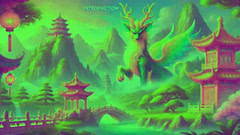Introduction
At the edge of river and ridge, where the imagined borders of the Yellow Emperor’s realm met the slow breath of wild mulberry groves, a woman moved like a quiet season. Her name, carried by those who would speak of her in temple halls and market lanes, was Leizu. In the hush before dawn she walked the terraces that her hands had helped plant, checking the slender trunks of mulberry trees as if they were her own children. Silk did not arrive to her fully formed; it arrived as a half-whisper, a sticky surprise clinging to a tiny leaf, a filament spun by an animal so ordinary the world had not yet learned its worth. The myth remembers the moment with tenderness: a cocoon, pale as ash and strange as the moon, dangling in a woven cradle of twigs. When a strand unwound and clung to a fingertip, Leizu did not merely notice; she listened. She listened the way a weaver listens to the rhythm of thread passing over a loom, the way a gardener listens to weather. Her curiosity was patient and practical, braided with a hunger for improvement that suited the Yellow Emperor’s court and the quiet needs of village households alike.
The discovery of silk is told here as a series of small, intimate decisions—how to coax a fragile beast into usefulness without breaking it; how to treat a material so fine it seems nearly sacred. The myth balances invention with respect, and invention here is not sudden divine fiat. Leizu’s knowledge grows out of observation, the careful tending of mulberry trees, the patient gathering of cocoons, the trial of boiling, teasing apart, and winding thread. She invents not because she seeks glory but because a society needs warmth, distinction, and economy. The earliest silks were not just luxurious cloth for ceremonial robes; they were practical, protective, and emblematic of a culture learning to transform the small gifts of nature into things that could bind families, inboxes of trade, and the identity of a people. In Leizu’s hands, silk becomes a conversation between nature and crafts, between domestic knowledge and imperial ambition. This retelling imagines the moment when a filament of silk, glistening like a thin moonbeam, first fell into a human palm and found its purpose. It imagines the infinite patience of Leizu’s loom, the quiet click and sigh of wooden frames, and the first garments that felt like memory against the skin. It asks how innovation moves from the household to the palace and beyond, and why stories of origin—of a single woman and a single strand—matter as much as the trade routes and statecraft that later carried silk to distant shores.
Of Leaves and Filaments: The First Lessons
The story of Leizu begins with a garden, and gardens are rarely idle things in myth. They are classrooms, laboratories, and the slow-work altars of practical wisdom. Her father had taught her to recognize the right sap in a mulberry branch; her mother had shown her how to braid a reed basket so it would bear weight and not split. From childhood she learned to be exact—how a small cut could encourage a branch to bear sweeter leaves, how a handful of ash in the pot could deter common pests. Village children watched but did not understand why Leizu spent so much time among the trees. She was young when she first noticed the tiny white cocoons clustered like rosebuds on the undersides of leaves, and curious in that way that must have unnerved some but delighted others. To Leizu, the world often spoke in quiet patterns: the way beetles preferred the lower leaves in the heat of noon, the way wind shaped the terraces’ thin soils, the way certain silkworms favored the leaves of some mulberries over others. Observation became craft.

One evening, as the sky simmered purple and lanterns began to sparkle in the emperor’s distant terraces, a single cocoon fell into Leizu’s lap. It rolled like a pale seed, and when she touched it, a filament unwound and caught on her finger like a silver cobweb. She did not pull; she held still and let the strand reveal itself. Where others might have recoiled at the filmy tangle, Leizu saw possibility. She gathered more cocoons and began experimenting: a touch of warmth here, a slow boiling there, gentle unwinding and patient reeling. Each attempt taught her something about tension and patience, about the brittleness of haste and the way gentle heat softened knots into usable thread.
Her first looms were modest—a frame of wood and twine in a small courtyard. She adapted tools used for basket-making to handle the delicate silk, inventing what would later be called a primitive loom. She paced her movements as if composing a slow song. The first cloth she wove was irregular, full of imperfections, but the sheen that emerged in candlelight had a quality that felt almost like grace. Word traveled, first through women who traded techniques at communal hearths, then by the merchants who saw not just fabric but the possibility of refinement, social currency, and ceremony. Leizu taught patiently, insisting that each thread honored the labor of the silkworms and the generosity of the trees. Instruction became ritual; technique became heritage. As more hands learned to reel and dye, patterns emerged—geometric borders that mirrored terrace lines and swirling motifs inspired by river eddies. The silk that came out of those early workshops was not merely a novelty; it was the first sign of a society turning delicate natural gifts into durable beauty.
Innovation in the myth is gentle and domestic, not thunderous. Leizu’s methods spread along family ties, women’s gatherings, and seasonal markets. Mothers taught daughters how to select the choicest leaves, how to shelter cocoons from damp, and how to turn reeling into an almost meditative practice. The empire’s scribes began to take notice—ledgers recorded not just tribute but new items: lengths of shimmering cloth with a sheen that seemed to catch starlight. The story suggests that cultural transformation needs both clever hands and patient networks: one person can see, two can refine, and many can sustain. Leizu’s loom taught her community an economy of attention; silk became a measure of care and continuity. The myth insists that invention without stewardship is fragile: the care of the mulberry trees, the benevolent oversight of the Yellow Emperor’s officials, and the women who kept techniques alive at kitchen fires were all necessary to transform a filament into a trade good that would span continents. In this way, the legend keeps its focus on the humble choreography of domestic life and the profound global ripples that can begin there.
Weaving the World: Looms, Courts, and the Long Silk Road
From household courtyard to imperial workshop, silk traveled like a thought becoming a thing. The Yellow Emperor’s court recognized silk’s peculiar power: it could clothe ceremonial bodies, signify rank, and be offered as tribute to allies and rivals. Leizu’s work, once a private curiosity, became a public resource. But the myth that surrounds her insists on the social texture behind every ribbon of silk—how so many hands and choices and losses stitched together the fabric of an empire. Court weavers refined the basic loom into more intricate frames, introducing heddles, tension bars, and patterned weft techniques that allowed for the elaborate brocades that would later impress envoys from distant lands. Leizu is remembered not as a solitary inventor who walked into fame but as a teacher whose quiet innovations empowered artisans to iterate and elaborate.

Silk’s alchemy—transformation from leaf to cloth—was embedded in daily rituals. The sericulture cycle became a calendar: spring brought mulberry pruning and the hatching of silkworms; summer demanded careful feeding and temperature control; autumn was for harvesting cocoons and beginning the long work of reeling and dyeing. Leizu taught the court and the countryside alike that success depended on humility before the seasons. The myth frames her as an interpreter of natural rhythms, someone who could read the language of leaves and of larvae. As silk production grew, so did the networks that carried it. Caravans, once limited to local markets, learned to carry light, compact bolts of silk across mountain passes and desert tracks. The material’s value made it a medium of cultural exchange: designs traveled with it, as did ideas about technique, fashion, and ceremony.
The Silk Road, as the world later called the network of routes that connected east and west, owes as much to quiet domestic innovations as to imperial ambition. In the tale, Leizu’s cloth is carefully packed into crates that smell faintly of mulberry, into bales that catch the sunlight through the cracks of caravans. Merchants who bought the first bolts recognized silk’s appeal: it was warm yet light, durable yet delicate in appearance. Silk became currency—payment for horses, gifts to princes, and diplomatic offerings that smoothed the edges of negotiation. Along the road, silk took on local meanings. A simple weave from Leizu’s early loom might be embroidered with Tibetan motifs in a mountain market, or dyed with Persian indigo in desert bazaars. Each adaptation kept a trace of its origin even as it joined new traditions. Leizu’s myth thus sketches a map of cultural osmosis: a woman’s invention traveling as cloth and as idea, gathering patterns and stories along the way.
Yet the legend never forgets the cost or the ethics. Sericulture required labor and expertise, and the guardianship of trees and animals. Leizu’s ethic is visible in each stage: she insists on humane treatment of silkworms until the moment of reeling, she encourages selective breeding and careful pruning to keep mulberry health high, and she advocates for sharing techniques freely among households. Her legacy, as told, shaped more than a luxury good; it created livelihoods, inspired new crafts, and linked local knowledge to imperial policy. The story implies that technology’s real power is relational: silk could insulate a child against winter, signify the bond between ruler and subject, and carry images of one culture into the hands of another. In the slow progression from filament to garment, Leizu’s name became a shorthand for the careful blending of curiosity, craft, and communal responsibility that made silk a wonder for the ages.
Conclusion
The myth of the Silkworm Goddess endures because it marries human ingenuity to patient care. Leizu’s story is not only about exhibition gowns or imperial splendor; it’s about how small, sustained acts can alter history. The legend preserves a model of innovation rooted in observation and communal practice, in which a single filament wound itself into the wider weave of a civilization’s economy and identity. Silk becomes, in this telling, a visible record of relationships: between women who taught each other by hearthlight, between villagers and the trees that fed their silkworms, and between rulers who recognized the value of new crafts and the artisans who made them. To speak Leizu’s name is to recognize that technologies often emerge at the edges of daily life, where patience and curiosity meet. Her myth invites us to honor the quiet work—gardening, tending, testing—that transforms possibility into cultural inheritance. It asks us to remember that every bolt of silk once began as a delicate strand, and that every strand requires a universe of care to become a thing of lasting beauty.


















